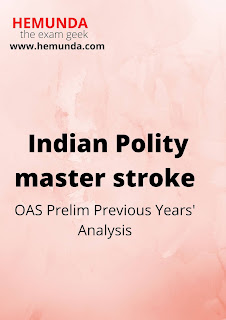Indian polity is a major portion of the Odisha civil services preliminary examinations( popularly known as OAS Prelim). Each year 15 to 20 questions are asked in the prelim exam from the Indian polity and governance section. Indian polity is the basic framework of civil services. We should have a clear visualization of all the topics of Indian polity mentioned in the syllabus.
Syllabus- Indian polity and governance-Constitution, political system, Panchayati raj, public policy, Rights Issues, etc.
Previous Years' Prelim Questions.
- Which act did change the designation of Governor-General of Bengal to Governor-General of India? 2015
Explanation:
Regulating Act of 1773
- It changed the designation of Governor of Bengal into Governor-General of Bengal.
- Warren Hastings became the first Governor-General of Bengal.
- It formed the Executive Council to help the Governor-General.
- The Executive Council, formed by the Regulating Act of 1773, had four members.
2.Who is associated with the introduction of local self-government in India? 2015
Explanation:
Lord Ripon who is regarded as the Father of Local government in India also mandated such an institution in its resolution in 1882
3.Which one of the following was the first committee to demand constitutional recognition for panchayats? 2015
Explanation:
Ashok Mehta Committee
4. In India, the 'collegium System' was first introduced in relation to what? 2015
Explanation:
- The Second Judges Case (1993) introduced the Collegium system, holding that “consultation” really meant “concurrence”.
- It added that it was not the CJI's individual opinion, but an institutional opinion formed in consultation with the two senior-most judges in the Supreme Court.
Explanation:
committee on Prevention of Corruption
6. Which constitutional amendment provided for the setting up of Administrative Tribunals in India? 2015
Explanation:
- Tribunals were not part of the original constitution, it was incorporated in the Indian Constitution by 42nd Amendment Act, 1976. Article 323-A deals with Administrative Tribunals.
7. Which of the following committee voiced concern about 'criminalization of politics and politicization of criminals'? 2015
Explanation:
Vohra committee
8.The provision of providing identity cards to voters has been made in the which act? 2015
Explanation:
- the Representation of the People Act 1958
9.What will follow if a Money Bill is substantially amended by the Rajya Sabha? 2015
Explanation:
- A Money Bill can be introduced only in the Lok sabha on the recommendations of the President.
- The Rajya sabha cannot initiate a Money Bill nor can it reject or amend it after passage by the Lok Sabha.
- The Rajya sabha must return a Money Bill within 14 days of receipt, after which the Lok sabha may accept any of its recommendations.
10. Rajya Sabha is dissolved after how many years? 2015
Explanation:
six years








































0 Comments
please do not enter any spam link in the comment box.